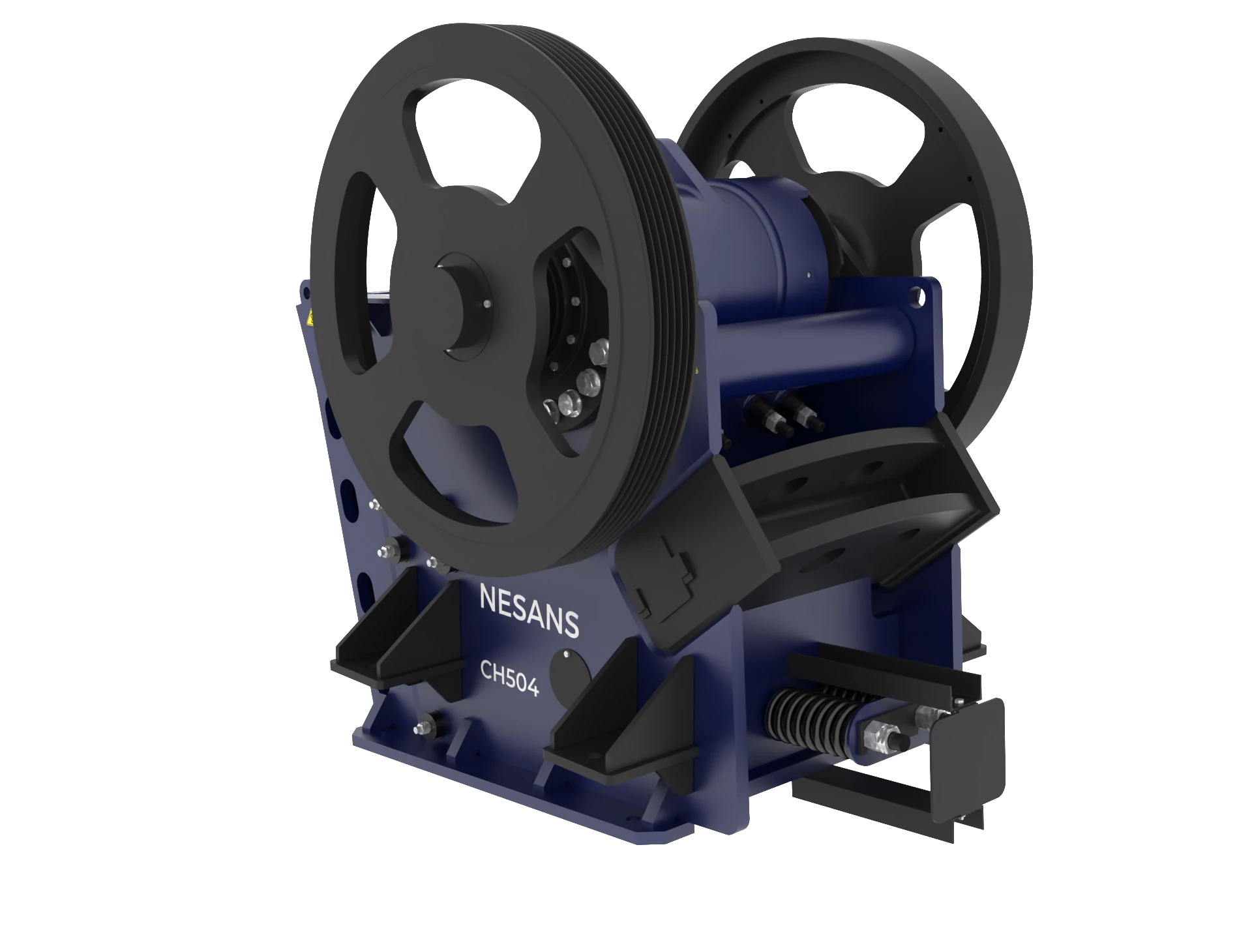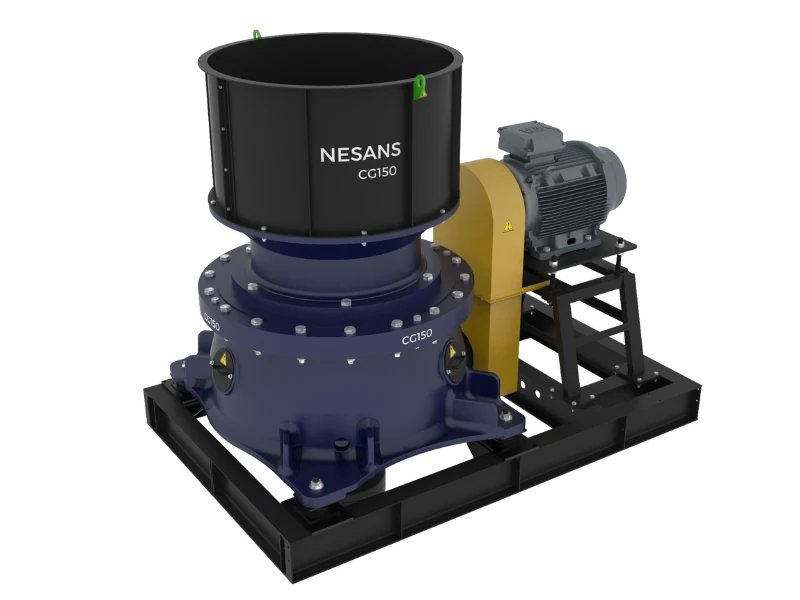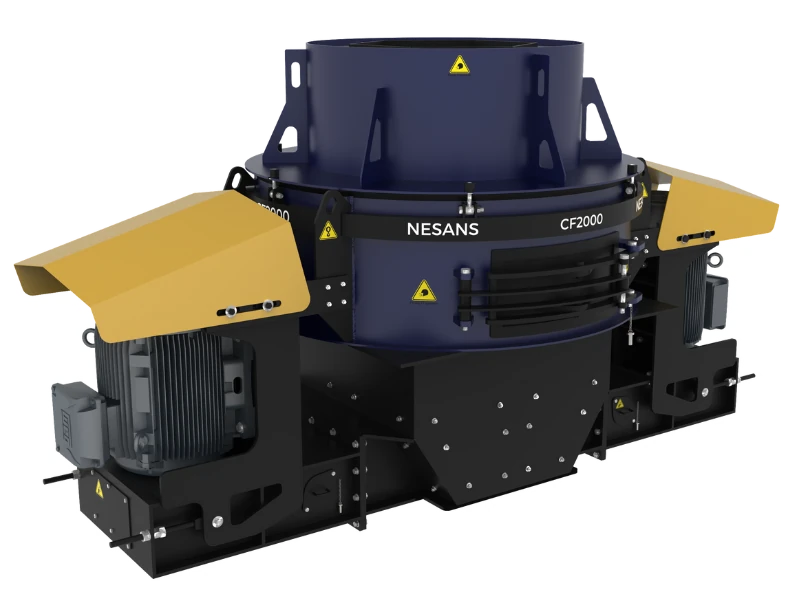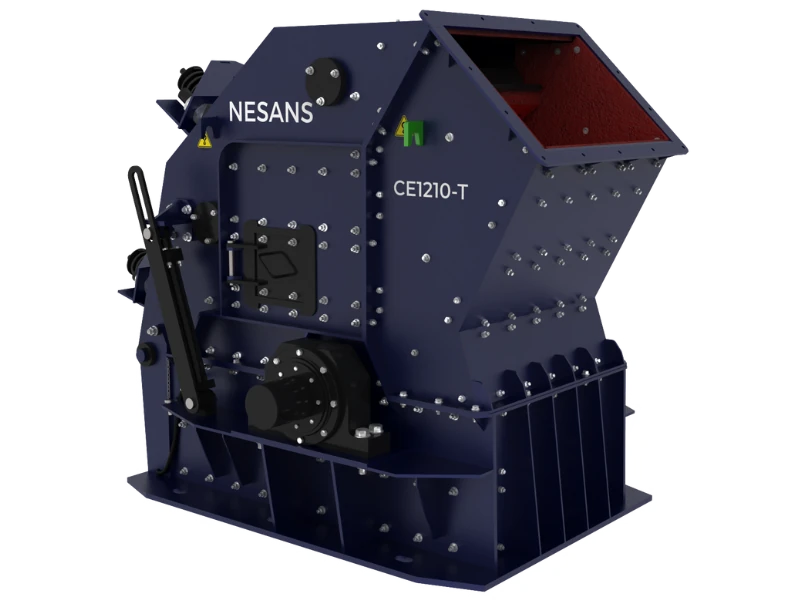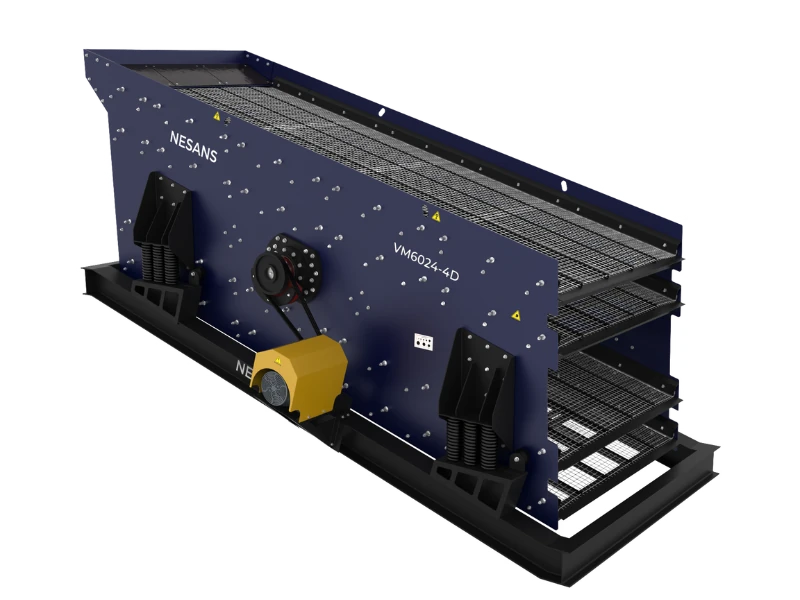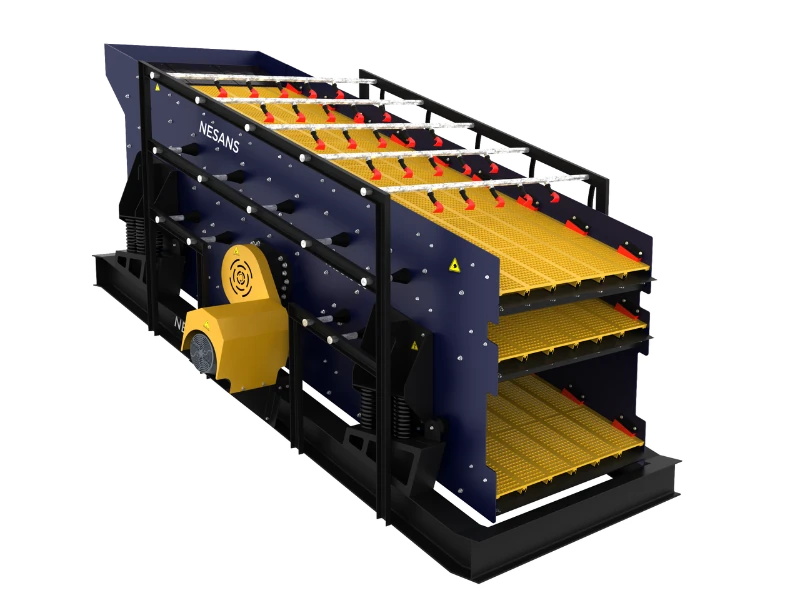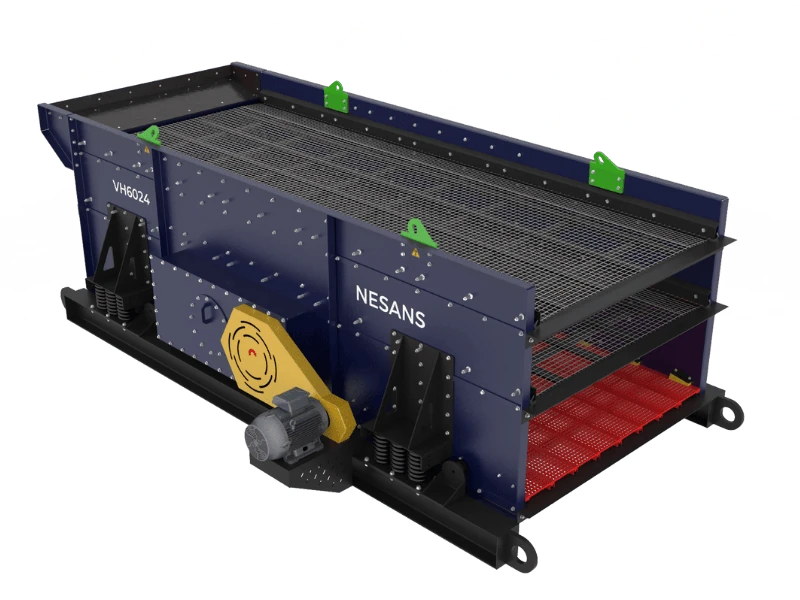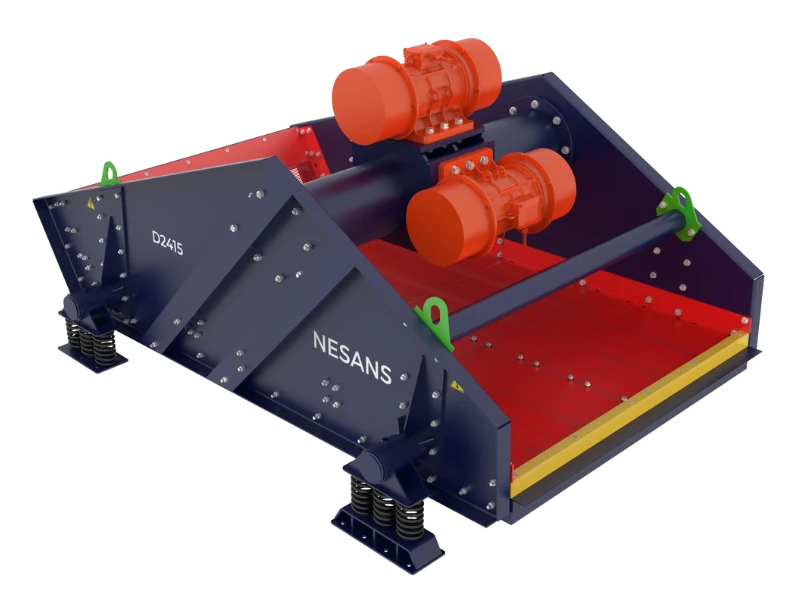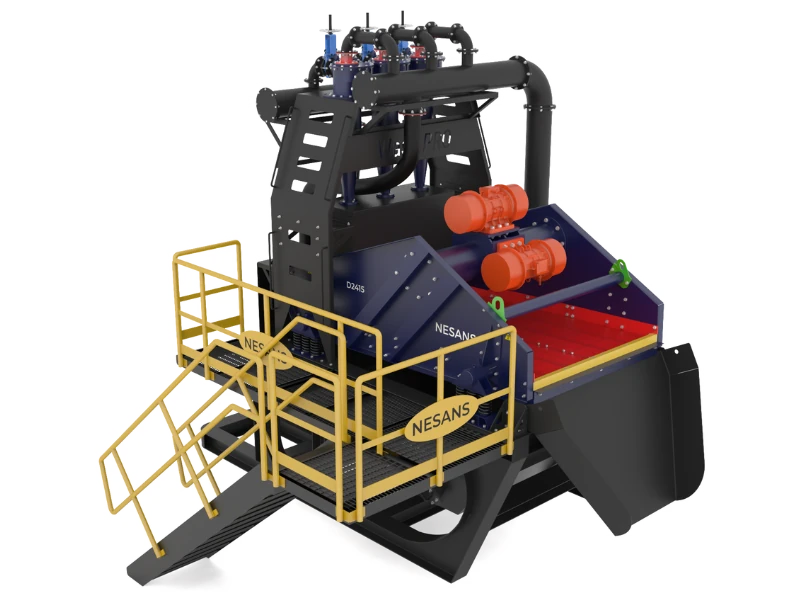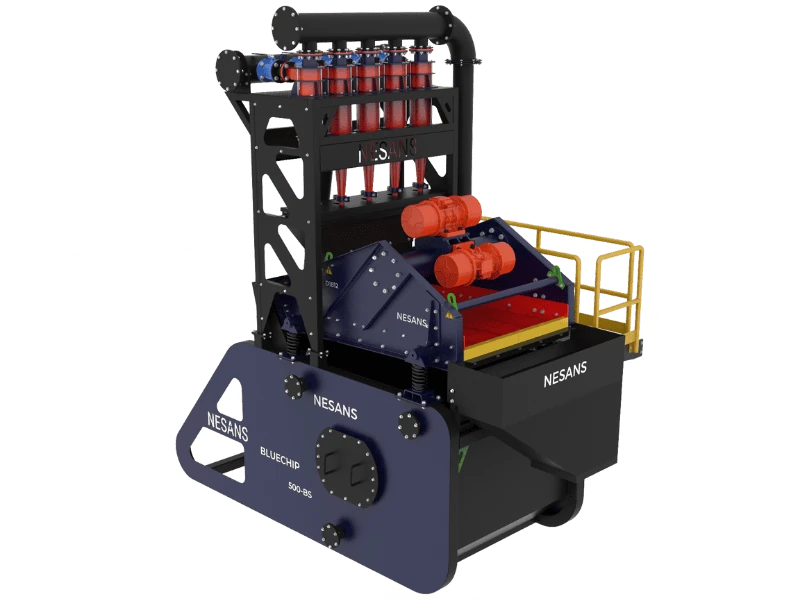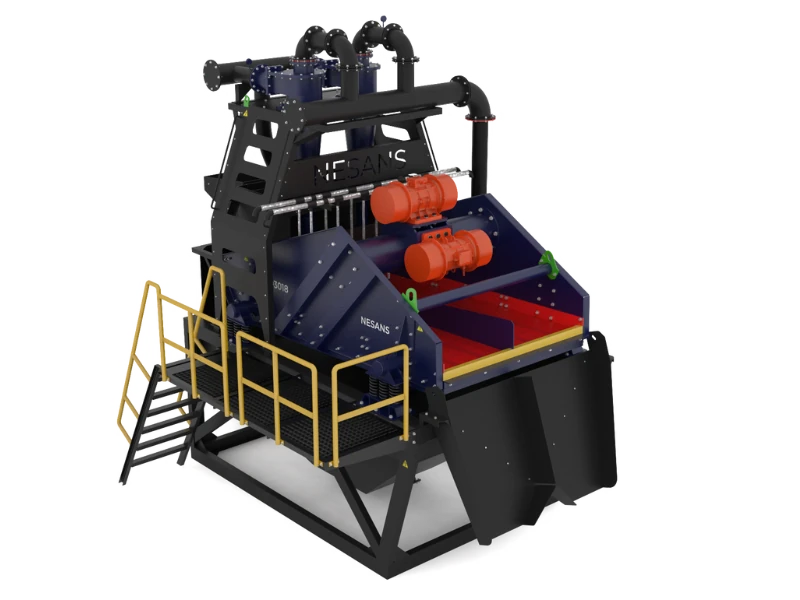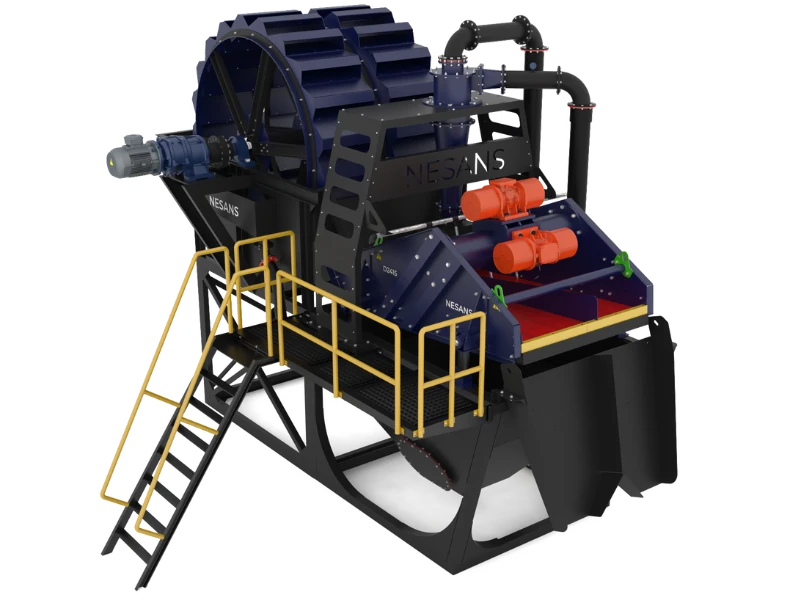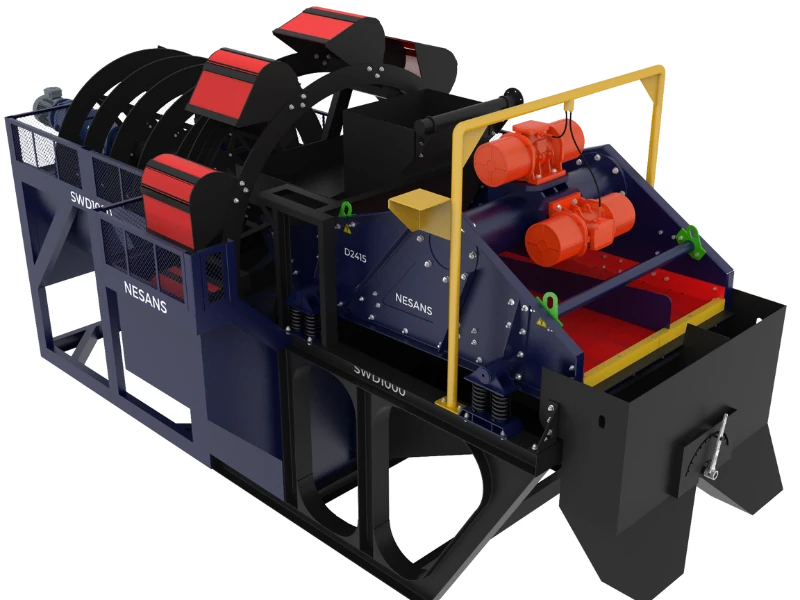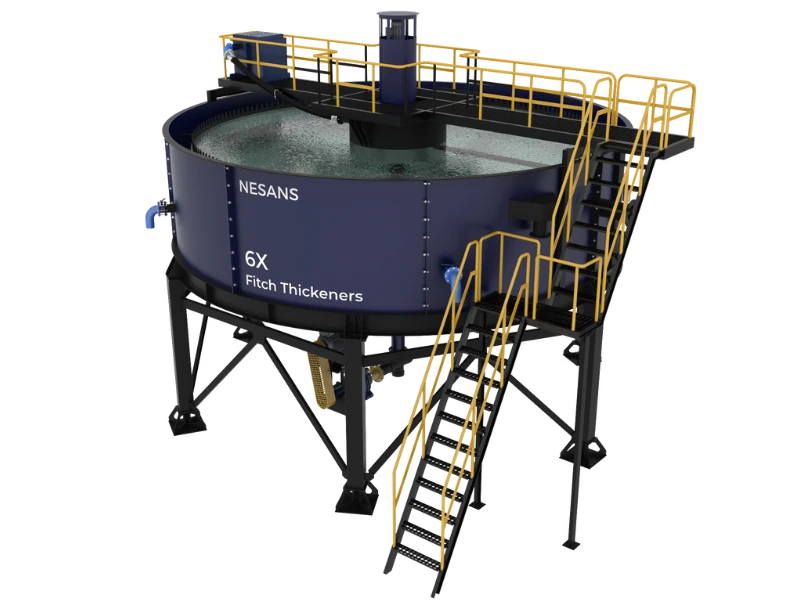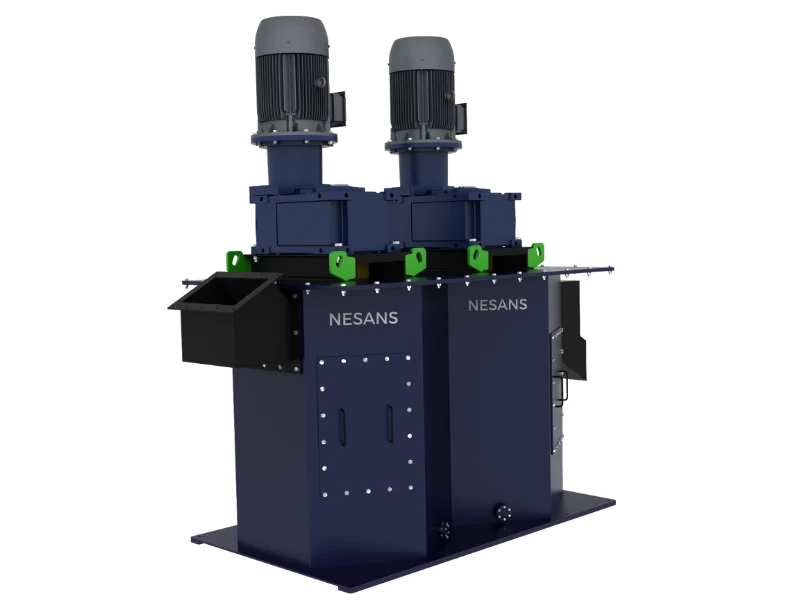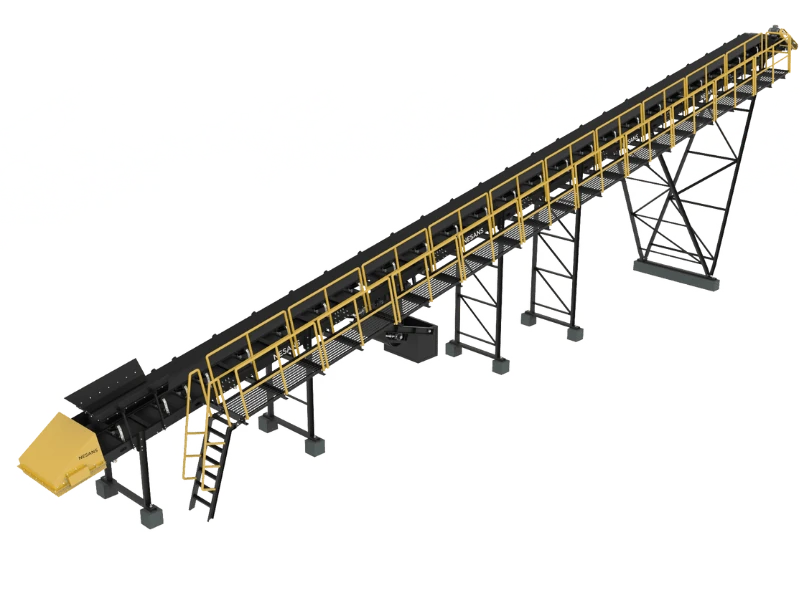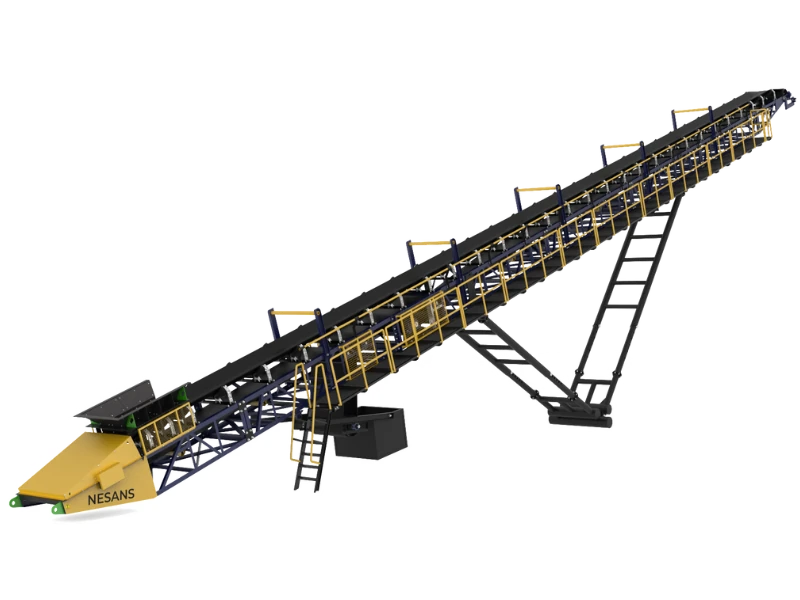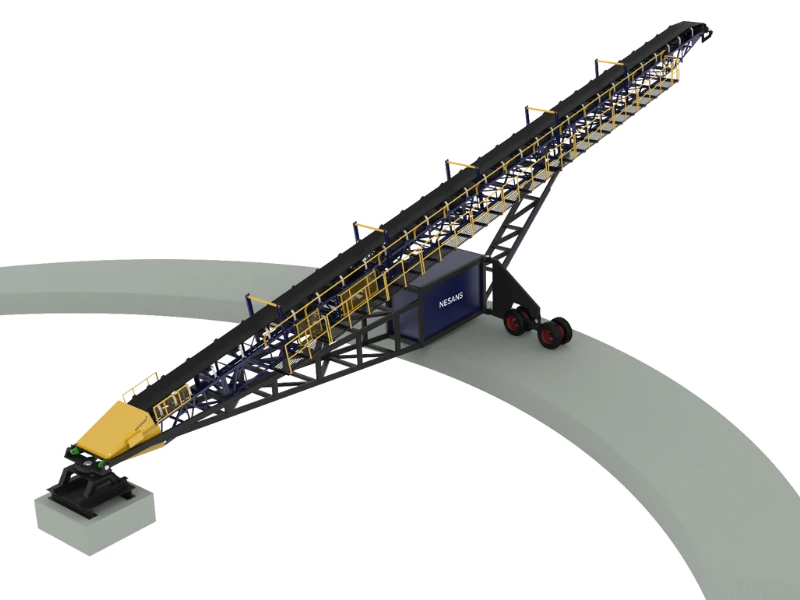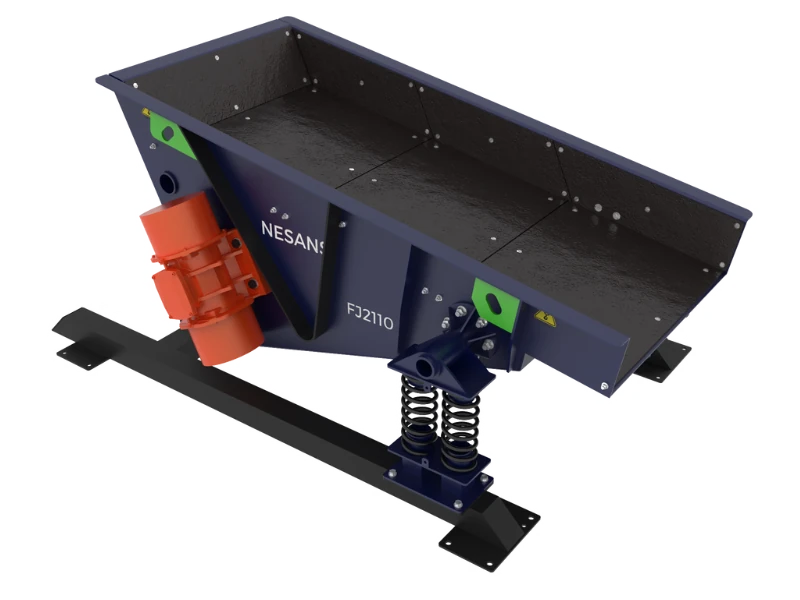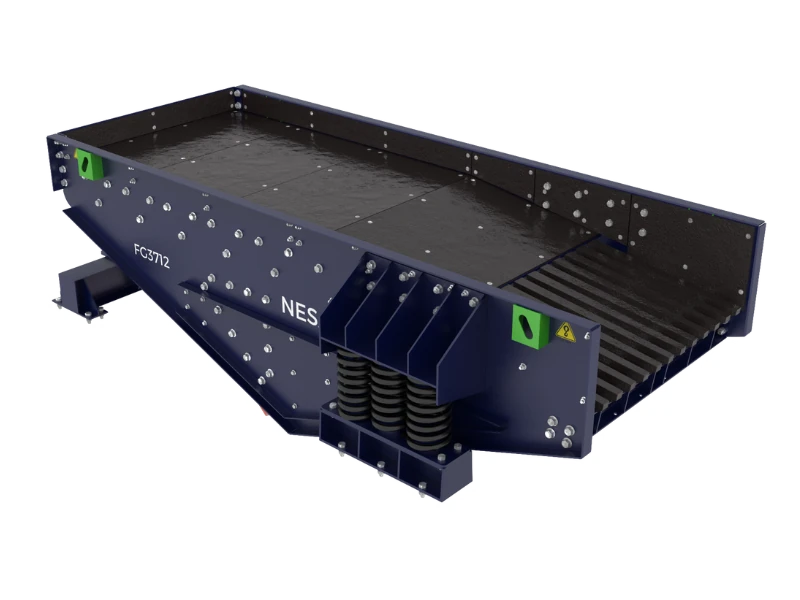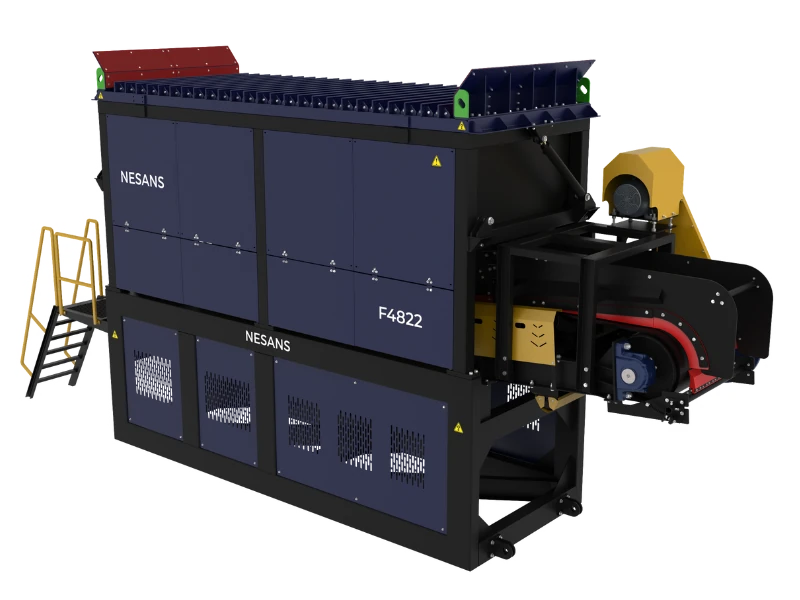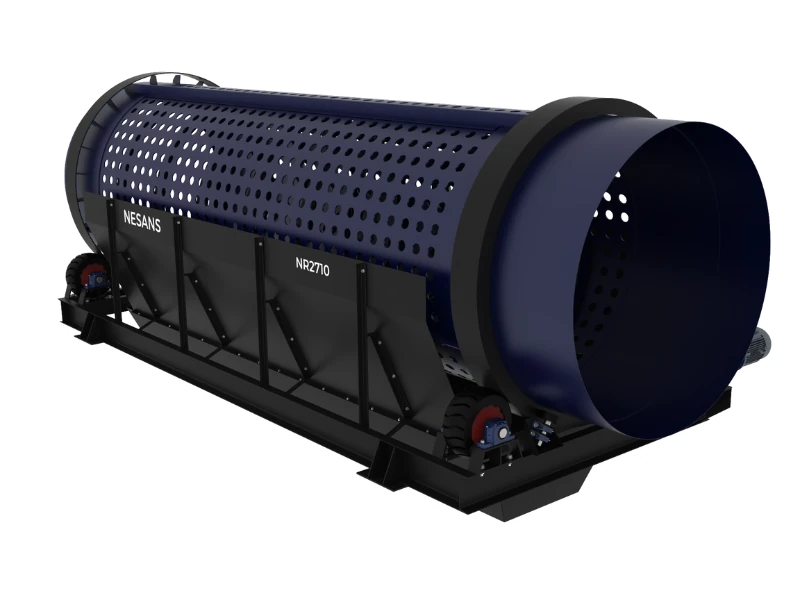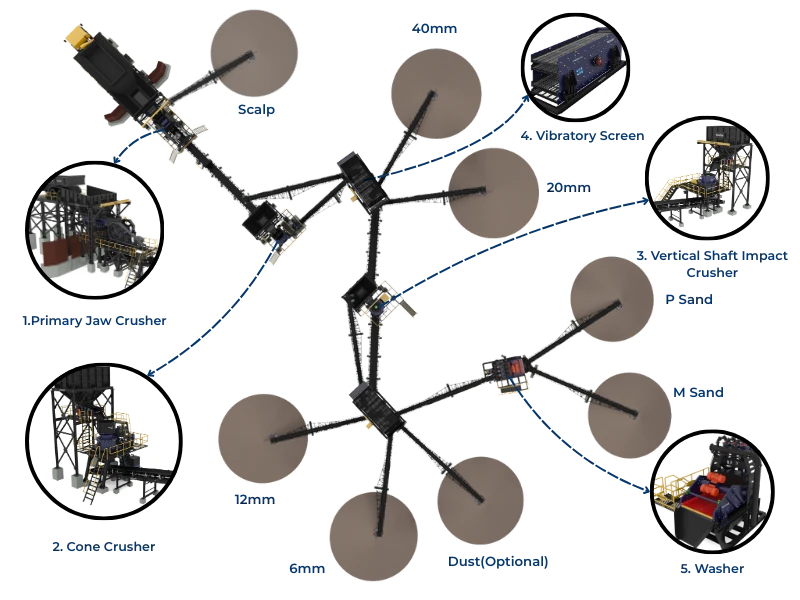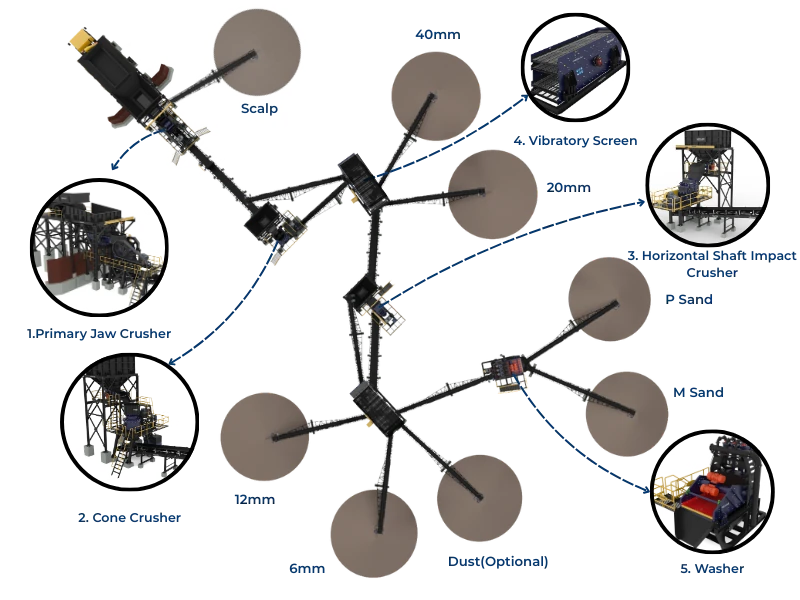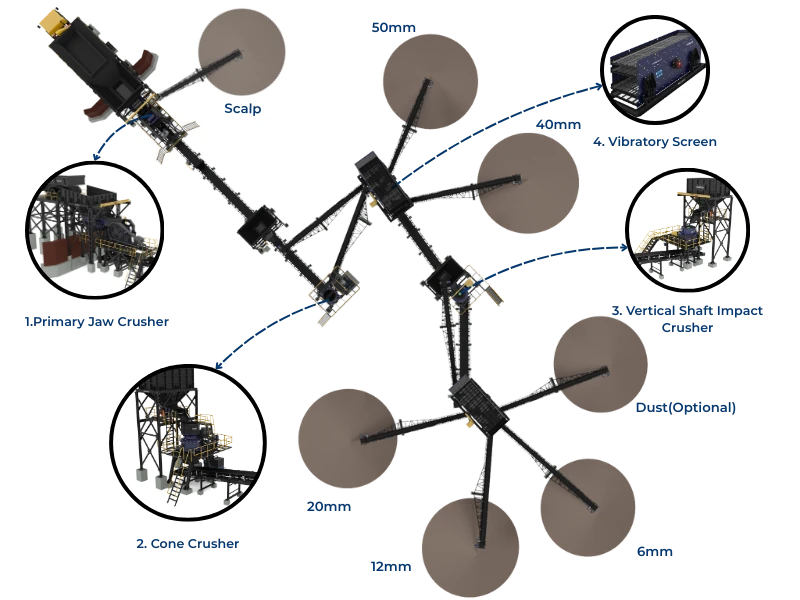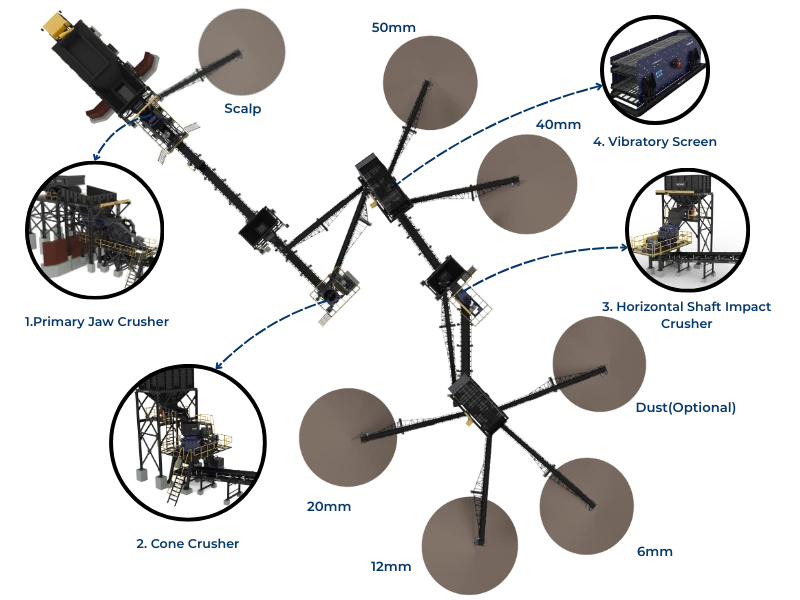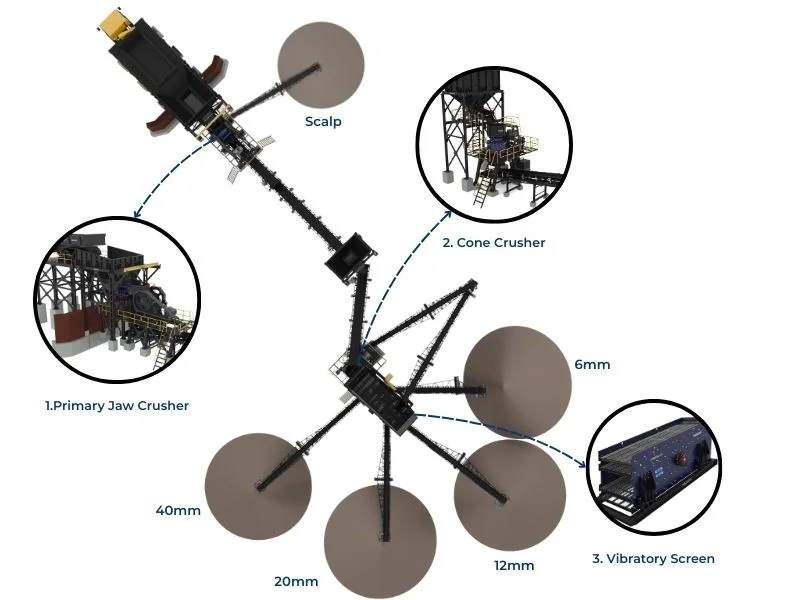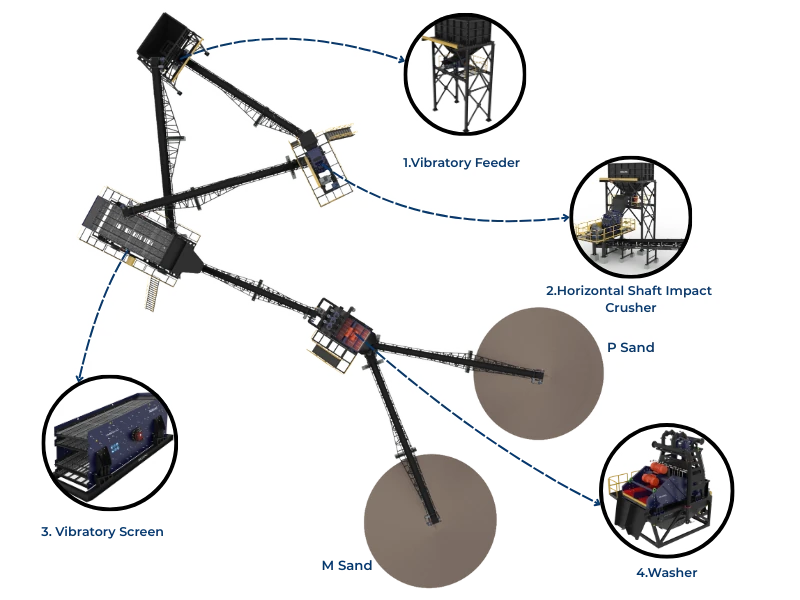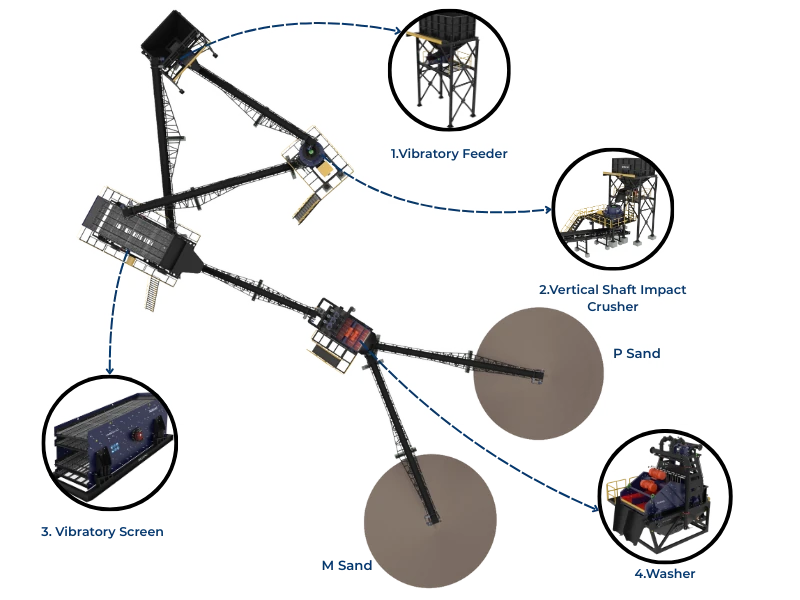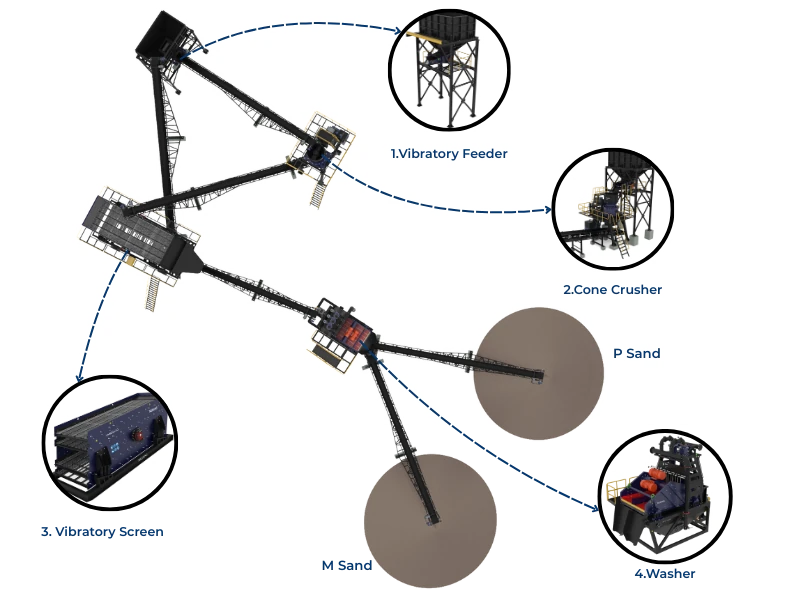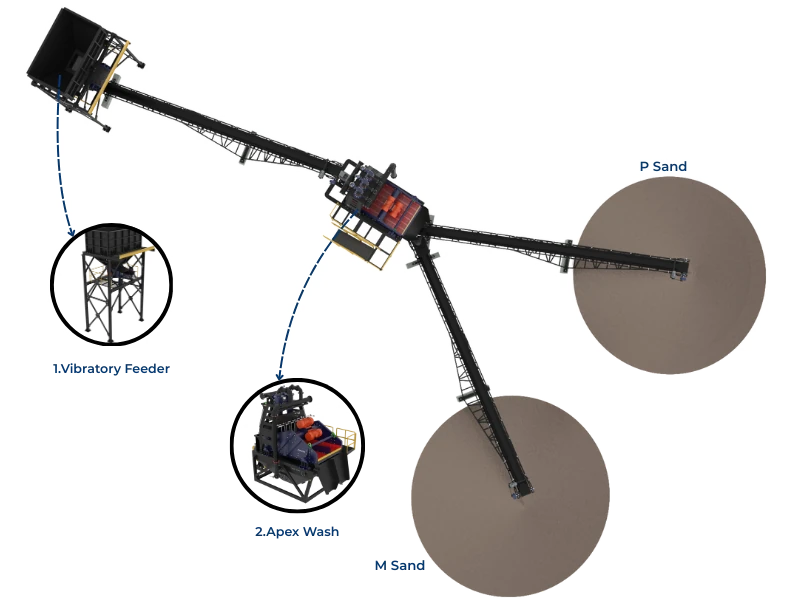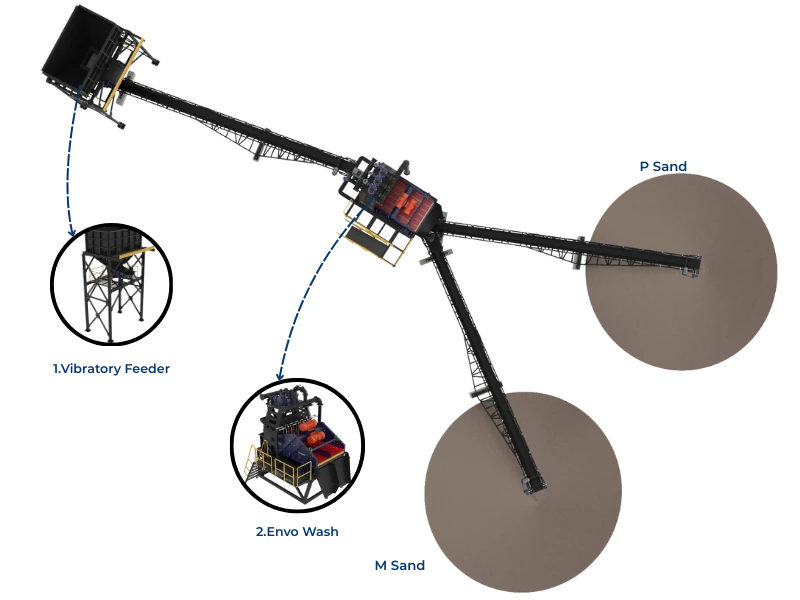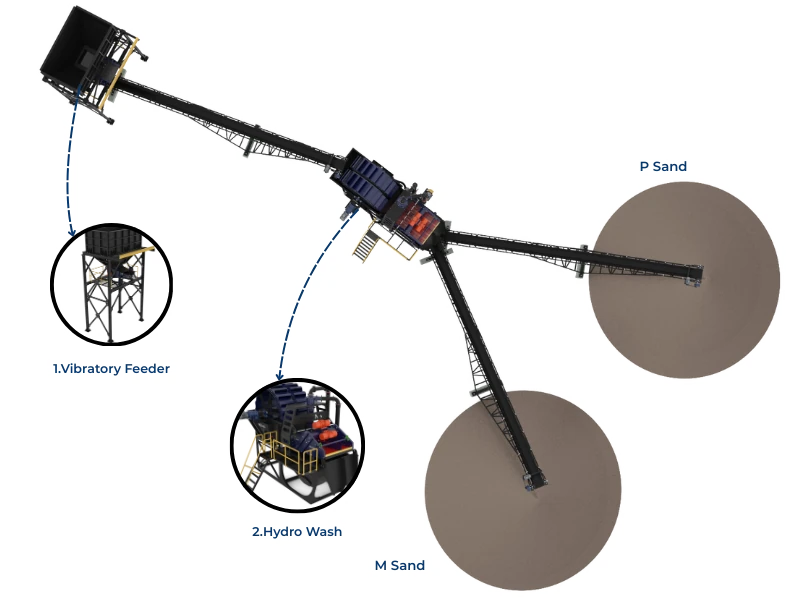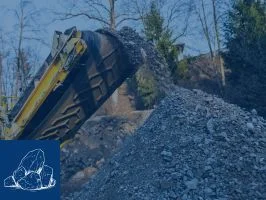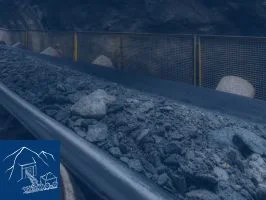A 200 TPH sand washing plant consuming 80-120 m³/hour of freshwater isn't just expensive—it's environmentally unsustainable and increasingly illegal. Yet most plants continue flushing 60-70% of their fines (valuable -75µm material worth ₹800-1200/ton) directly to settling ponds, losing ₹15-25 lakhs monthly in material value while facing groundwater depletion penalties and discharge violations.
Water management in sand washing operations represents one of the most impactful yet overlooked optimization opportunities in aggregate processing. While producers invest heavily in crushers and screens, washing systems—which determine final product cleanliness, grading accuracy, and environmental compliance—often operate with open-loop water systems that waste both water and valuable fines. The solution isn't just adding settling ponds or hoping for natural clarification; it requires engineered clarification systems, strategic flocculation, and properly designed closed-loop circuits.
This guide examines the engineering principles behind effective water management in sand washing plants, focusing on practical techniques to cut freshwater consumption by 40-60% while recovering 85-95% of fines for additional revenue and environmental compliance.
Understanding Water Usage in Sand Washing
Sand washing consumes water for three distinct purposes, each with different quality requirements and recycle potential:
- Primary Washing: Removes clays, silts, and surface coatings—requires highest flow rate (60-70% of total consumption), moderate quality acceptable
- Classification/Dewatering: Achieves final grading and moisture content—requires 20-30% of total water, needs lower silt loading
- Equipment Cleaning: Maintains screen and tank surfaces—10-15% of water use, can use lower quality water
A typical 150 TPH sand plant washing -5mm material uses:
- Total water consumption: 90-120 m³/hour
- Water-to-solids ratio: 4-6:1 by volume at washing stage
- Suspended solids in discharge: 30,000-60,000 ppm (3-6% by weight)
- Fines content in discharge water: 8-15% of feed tonnage (12-22 TPH lost fines)
Without recycle systems, this translates to 1,800-2,400 m³/day freshwater consumption and 200-350 tons/day of fines loss—material that could generate ₹1.5-4 lakhs daily revenue if recovered and processed.
Clarification Fundamentals: Turning Muddy Water into Reusable Resource
Sedimentation Principles
Sedimentation relies on gravity to separate suspended particles from water. The settling velocity of a particle is governed by Stokes' Law:
v = (ρₛ - ρw) × g × d² / (18 × μ)
Where:
- v = Settling velocity (m/s)
- ρₛ = Particle density (typically 2650 kg/m³ for sand)
- ρw = Water density (1000 kg/m³)
- g = Gravitational acceleration (9.81 m/s²)
- d = Particle diameter (meters)
- μ = Dynamic viscosity of water (0.001 Pa·s at 20°C)
This explains why natural settling is inadequate for fine particles:
- 100µm particle: Settles at ~0.6 cm/s (2.2 m/hour) - settles in reasonable time
- 20µm particle: Settles at ~0.02 cm/s (0.7 m/hour) - requires 10-15 hours for 10m depth
- 5µm particle: Settles at ~0.001 cm/s (0.04 m/hour) - requires 250+ hours, essentially stays in suspension
⚠️ Impact on Water Quality: A settling pond designed for 4-hour retention will clarify water to ~2000-5000 ppm suspended solids (removing >75µm particles) but leaves 60-75% of clay and ultra-fine silica in suspension. Recycling this water back to washing systems creates accumulation—each cycle concentrates fines until suspended solids reach 8,000-15,000 ppm, making the water unsuitable for dewatering screens and classification equipment.
Thickener Design and Operation
Thickeners accelerate sedimentation through two mechanisms: increased surface area (longer residence time) and controlled underflow removal (prevents resuspension).
Key Design Parameters:
- Surface Loading Rate: 0.5-1.5 m³/m²/hour for sand plant water (higher for coarser particles, lower for clay-contaminated feeds)
- Retention Time: 4-8 hours for effective clarification without chemical aids
- Underflow Density: Target 40-60% solids by weight for handling and dewatering
- Overflow Clarity: <1000 ppm suspended solids for reuse in washing circuits
For a 150 TPH sand plant generating 100 m³/hour of process water with 5% suspended solids:
- Required thickener surface area: 100 m³/hr ÷ 1.0 m³/m²/hr = 100 m² minimum
- Diameter for 100 m² = 11.3 meters
- Volume for 6-hour retention: 100 m³/hr × 6 hr = 600 m³ total volume
- With 100 m² area: Average depth = 600 m³ ÷ 100 m² = 6 meters depth
Undersizing thickeners is one of the most common design errors—attempting to use a 50 m² thickener for 100 m³/hour throughput (2.0 m³/m²/hr loading) results in overflow turbidity of 3,000-8,000 ppm, making water marginally suitable for reuse.
Chemical Flocculation: Accelerating Nature by 100×
Flocculation Chemistry
Flocculants are long-chain polymers that bridge between individual particles, creating larger agglomerations (flocs) that settle 50-200× faster than individual particles. This transforms uneconomical 20-hour settling processes into 15-30 minute operations.
Flocculant Types and Selection:
- Anionic (Negative Charge): Best for sand, silica, and most aggregates—general purpose selection
- Cationic (Positive Charge): Effective for clay-heavy feeds, organic material removal
- Non-ionic: Specialized applications, minimal impact on water pH
Molecular Weight Selection:
- Low MW (3-6 million): Fast mixing, smaller flocs, used for very fine particles <10µm
- Medium MW (8-12 million): General purpose for sand washing, 15-50µm optimal range
- High MW (15-20+ million): Large particle bridging, use when coarse particles dominate
Flocculation System Design
Flocculant Preparation:
Flocculants are supplied as powder or emulsion and must be dissolved before use:
- Mixing Concentration: 0.1-0.5% active polymer (1-5 kg/m³ water)
- Mixing Time: 30-60 minutes with gentle agitation to fully hydrate polymer chains
- Aging Time: Use prepared flocculant within 24-48 hours—polymer chains break down over time
- Addition Rate: 20-100 g/ton of dry solids (0.002-0.01% by weight)
Dosing and Mixing:
- Initial Mixing: Add flocculant to turbulent process water stream with 30-60 seconds contact time
- Flocculation Zone: Gentle mixing (20-40 RPM paddle) for 2-5 minutes to allow floc formation
- Settling Zone: Quiescent conditions (no agitation) for floc settling—typically in thickener tank
⚠️ Impact on Water Recovery: Proper flocculation reduces thickener overflow from 5,000 ppm to <500 ppm suspended solids, enabling water reuse for all washing operations. At 100 m³/hour circulation, this represents recovery of 450 kg/hour of fines—10.8 tons/day worth ₹10,000-15,000 in material value. More importantly, it enables 85-90% water recycle rates, reducing freshwater makeup from 100 m³/hr to 10-15 m³/hr.
Closed-Loop Water Circuit Design
System Architecture
An effective closed-loop system balances water quality with reuse rate through strategic staging:
Primary Loop (60-70% of total flow):
- Source: Thickener overflow at <1000 ppm suspended solids
- Use: Primary log washers, bucket sand washers, initial rinsing
- Quality Requirement: Moderate - can tolerate 800-1500 ppm solids
Secondary Loop (20-30% of flow):
- Source: Post-dewatering screen drainage at <500 ppm solids
- Use: Fine sand washing, final dewatering sprays, classification
- Quality Requirement: High - requires <300 ppm for accurate sizing
Makeup Water (10-15% of total):
- Source: Freshwater supply
- Use: Critical dewatering, product moisture control, system top-up
- Quality: Potable or process water standard
Nesans bucket sand washers are designed for efficient operation with recycled water, featuring adjustable water input controls and integrated dewatering that minimizes freshwater requirements.
Underflow Management: Fines Recovery
Thickener underflow contains valuable fines at 40-60% solids—too wet for direct handling but ideal for further processing.
Dewatering Options:
- Filter Press: Dewaters to 70-85% solids (cake form), suitable for bagging or stockpiling. Processing cost: ₹150-250/ton
- Centrifuge: Continuous operation, dewaters to 65-75% solids, higher throughput. Cost: ₹200-300/ton
- Drying Beds: Natural evaporation over 5-15 days depending on climate. Lowest cost but requires land area and weather-dependent
- Blend-Back to Product: Controlled re-introduction of dewatered fines into coarser sand products (5-15% addition) to improve grading and recover value
For a 150 TPH sand plant recovering 15 TPH (10%) of fines from process water:
- Daily fines recovery: 300-360 tons/day
- Value at ₹1000/ton (manufactured sand supplement): ₹3-3.6 lakhs/day revenue
- Processing cost (filter press): ₹75,000/day
- Net benefit: ₹2.25-2.85 lakhs/day (₹67-85 lakhs/month)
Water Balance and Makeup Requirements
Calculating System Water Demand
Effective closed-loop design requires understanding water losses and makeup needs:
Water Loss Mechanisms:
- Product Moisture: Sand at 8-12% moisture carries away 8-12 kg water per ton of product - 150 TPH production = 15,000 kg/hr moisture loss (15 m³/hour)
- Fines in Underflow: Recovered fines at 50% moisture content remove water from system - 15 TPH fines at 50% moisture = 7.5 m³/hour water removal
- Evaporation: From open tanks and ponds, climate-dependent - Typical: 5-8 mm/day from exposed surfaces = 2-5 m³/hour for large system
- Spillage and Leaks: Equipment drainage, spray overspray, minor leaks - Typical: 2-5 m³/hour for well-maintained system
Total Makeup Requirement:
15 + 7.5 + 3.5 + 3.5 = 29.5 m³/hour (~30 m³/hr freshwater makeup)
This represents 25-30% of the original 100-120 m³/hour consumption—achieving 70-75% water recycle rate without sophisticated dewatering. With advanced fines recovery and moisture control, recycle rates of 85-90% are achievable.
Water Quality Monitoring
Closed-loop systems require active monitoring to prevent quality degradation:
Critical Parameters:
- Suspended Solids: Measure daily at thickener overflow, screen drainage, and makeup points. Target: <1000 ppm for washing reuse
- pH: Monitor weekly—should remain 7-9 for most operations. Drift indicates chemical accumulation or contamination
- Dissolved Solids: Monthly measurement—buildup indicates inadequate bleed/purge. Target: <5000 ppm TDS
- Turbidity (NTU): Rapid field measurement—correlates to suspended solids. Target: <100 NTU for classification water
Implement a 5-10% bleed rate (purge of recycle water replaced with fresh) to prevent accumulation of dissolved salts and ultra-fine particles that resist flocculation.
ROI and Environmental Benefits
Financial Returns
For a 150 TPH sand washing plant operating 300 days/year, implementing comprehensive water management:
Water Cost Savings:
- Freshwater reduction: 70 m³/hr × 20 hr/day × 300 days = 420,000 m³/year
- At ₹15-25/m³ water cost: ₹63-105 lakhs/year savings
Fines Recovery Revenue:
- Recovered fines: 15 TPH × 20 hr/day × 300 days = 90,000 tons/year
- At ₹1000-1200/ton value: ₹9-10.8 crores/year revenue
- Less processing costs (₹200/ton): ₹1.8 crores
- Net fines benefit: ₹7.2-9 crores/year
Regulatory Compliance:
- Avoid groundwater extraction penalties: ₹50-150 lakhs/year
- Eliminate discharge violations: ₹25-75 lakhs/year in avoided fines
- Meet Zero Liquid Discharge (ZLD) requirements without evaporation ponds
Total Annual Benefit: ₹8-11 crores
Capital Investment Required:
- 10-12m thickener with drive: ₹40-55 lakhs
- Flocculation system: ₹8-12 lakhs
- Pumping and distribution: ₹15-20 lakhs
- Filter press (15 TPH): ₹35-50 lakhs
- Total: ₹1-1.4 crores
Payback Period: 1.5-2 months
Environmental Impact
- Groundwater Preservation: Reduce extraction by 400,000+ m³/year—equivalent to annual water needs of 4,000-5,000 people
- Stream/River Protection: Eliminate 90,000 tons/year of sediment discharge, preventing water body contamination
- Land Use Reduction: Replace 2-4 hectares of settling ponds with compact thickener, freeing land for production
- Carbon Footprint: Reduce freshwater pumping energy by 70%, cutting CO₂ emissions by 150-200 tons/year
Implementation Roadmap
Phase 1: Assessment and Design (2-4 weeks)
- Measure current water consumption and quality at all process points
- Characterize fines content, particle size distribution, and settling behavior
- Calculate required thickener size and flocculation system capacity
- Design piping and distribution for closed-loop circulation
- Select fines dewatering method based on volume and end-use requirements
Phase 2: Equipment Procurement and Installation (6-10 weeks)
- Order thickener, flocculation system, dewatering equipment
- Prepare civil works—thickener foundation, pump sumps, piping routes
- Install equipment with proper integration to existing washing circuit
- Commission water quality monitoring systems
Phase 3: Commissioning and Optimization (2-4 weeks)
- Start thickener with freshwater to establish settling baseline
- Introduce flocculation system—optimize dosage and mixing for clarity
- Gradually increase recycle rate while monitoring water quality
- Fine-tune underflow density and establish fines dewatering workflow
- Achieve target 85-90% recycle rate and <1000 ppm overflow clarity
Phase 4: Ongoing Optimization (Continuous)
- Weekly water quality testing and flocculant dosage adjustment
- Monthly thickener rake inspection and underflow density verification
- Quarterly system audit—measure actual recycle rates and freshwater consumption
- Annual review of fines recovery value and processing costs for optimization
Conclusion: Water as Both Resource and Revenue Stream
Sand washing water isn't waste—it's a carrier of valuable fines and a recyclable process input. Plants that treat water management as an afterthought waste millions in material losses and freshwater costs while facing increasing regulatory pressure and groundwater scarcity. Those that apply engineering principles to clarification, flocculation, and closed-loop design transform water from a cost center into a profit generator.
The shift from open-loop to closed-loop water management isn't optional anymore—it's driven by economics (₹8-11 crore annual benefit), environmental responsibility (400,000 m³/year groundwater preservation), and regulatory compliance (ZLD requirements). The capital investment pays for itself in 2-3 months, and the operational benefits—consistent water quality, reduced chemical costs, fines revenue—continue year after year.
Remember: Every liter of water you discharge carries 30-60 grams of saleable fines. Multiply that by 100,000 liters/hour, 20 hours/day, 300 days/year, and you're flushing ₹9-11 crores down the drain annually. Close the loop, recover the fines, and turn your washing system into one of the most profitable components of your operation.
Ready to Cut Water Costs by 70% While Adding ₹9+ Crores Annual Revenue?
Nesans provides complete sand washing solutions with integrated water management—from efficient bucket sand washers designed for recycled water operation to thickeners, flocculant systems, and fines recovery equipment.
Contact our process engineering team for a free water usage assessment and closed-loop system design tailored to your sand washing operation.

